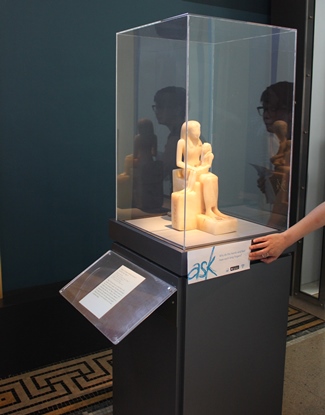Labels Do Heavy Lifting for ASK
As part of our original messaging with soft launch, we deployed gallery labels advertising the app. This first round included questions that we hoped would pique curiosity and motivate visitors to download the app to get an answer. They worked well…maybe a little too well. What we were finding is that roughly 30% of app users asked us about the works with ASK labels, which is great, except that a surprisingly large percentage (also about 30%) of those users would ONLY ask us those questions. No matter how much we invited them to ask their own questions or share their own thoughts, sending those labels (often just pictures, not even typing in the question) was enough for some users.

The first round of ASK labels featured a questions with a large, blue ASK logo that was very visible in the galleries though the final version was smaller than the test version shown here.
Given our lofty engagement goals for ASK, we started to question this type of exchange. It felt too superficial and not at all what we were hoping for as far as engaging visitors with art. Additionally, Shelley and I began to worry about how these seeded questions were polluting our data. After all, one of the most important aspects of ASK is what we learn about what visitors want to know and providing questions doesn’t offer us that organic insight.
So as part of our Launch (with a capital “L”) we revisited the gallery labels, removed questions and instead focused on advertising the app with a variety of generic invitations to ask. While admittedly having any label at all would potential skew the data in favor of visitors asking about those objects, at least the questions would be original to the visitor. We noted in the dashboard which works had ASK labels so that we would know if “most-asked about” works were ones with labels or not.

The updated version of the ASK labels focused on generic invitations such as “ask us for more info,” and blended in with the label design.
During soft launch, 31 out of the top 100 most-asked about works had first round question labels. For Launch, only 5 of the top 100 works were ones with ASK labels. That’s a huge difference. One caveat that is important to note, is that the visibility of the labels themselves decreased because the design approach changed radically in the second version. In both cases, as we’d seen before, most questions were about works in the permanent collection. However we’re seeing a shift in that this exhibition season (more to come in a future post).

For special exhibitions we include ASK messaging with the introductory text as well as with individual objects. Early versions, such as this one from the Sneaker exhibition from summer 2015, did not include a directive to “download,” which we include now.
Special exhibitions provided great opportunities to test different versions of ASK labels and we went through several variations trying to find the right combination of visibility and prompting while keeping the invitation fairly generic. Interestingly, works with ASK labels in special exhibitions have also averaged about 30% of app traffic in those shows with the exception of the recent Beverly Buchanan exhibition, where we reinstated question labels. Those works represented 52% of user queries. However, unlike the first version of ASK question labels, rarely did users ask the question on the label.
I’ll be curious to see how this compares to the questions in the Marilyn Minter exhibition up now. As I hinted above, we’ve seen a lot more chats in special exhibitions recently and, anecdotally, people are using the ASK question labels in the Minter show, which doesn’t close until May, so I’ll have to wait and see.
What all this tells me is that although the provided questions may have skewed our data in terms of determining visitors’ organic curiosities and questions, they were also doing some heavy lifting in terms of getting people into and using the app. This also speaks to one of the issues raised in our recent evaluation about some visitors feeling pressure to ask a question or just not having one readily available. Looks like perhaps these prompted questions were helping those folks get into the app so you’ll see those begin to roll out again both in special exhibitions and in the permanent collection in the coming weeks.

Sara Devine joined the Brooklyn Museum as Manager of Interpretive Materials in 2011 and is now Director of Visitor Experience & Engagement. A vocal visitor advocate, her expertise lies in crafting accessible and engaging visitor experiences and reaching audiences across platforms. She works with curators, designers, educators, technologists, and editors on all aspects of visitor experience and engagement. Sara is also a visiting assistant professor and curriculum coordinator at Pratt Institute’s School of Information for their graduate program in Museums and Digital Culture. She was previously Senior Content Developer and Project Manager at Hilferty, a museum planning and design firm in Ohio, where she developed comprehensive interpretive master plans and exhibitions for a wide variety of museums. She has also worked at Assistant Curator, Special Exhibition at Thomas Jefferson’s Monticello and as a Curatorial Assistant at the Smithsonian Museum of Natural History.


Emily Sachar - 7 years ago
Such an interesting article. The self-criticism of the ASK team, and the desire not to pollute your own research by overly directing museum visitors, is fascinating and commendable. I’m curious what your research shows after the Minter exhibition closes. I’m always keen to know the sorts of questions you see from users — topics and depth of interest. Maybe you can report in to the guides soon! Thanks again!